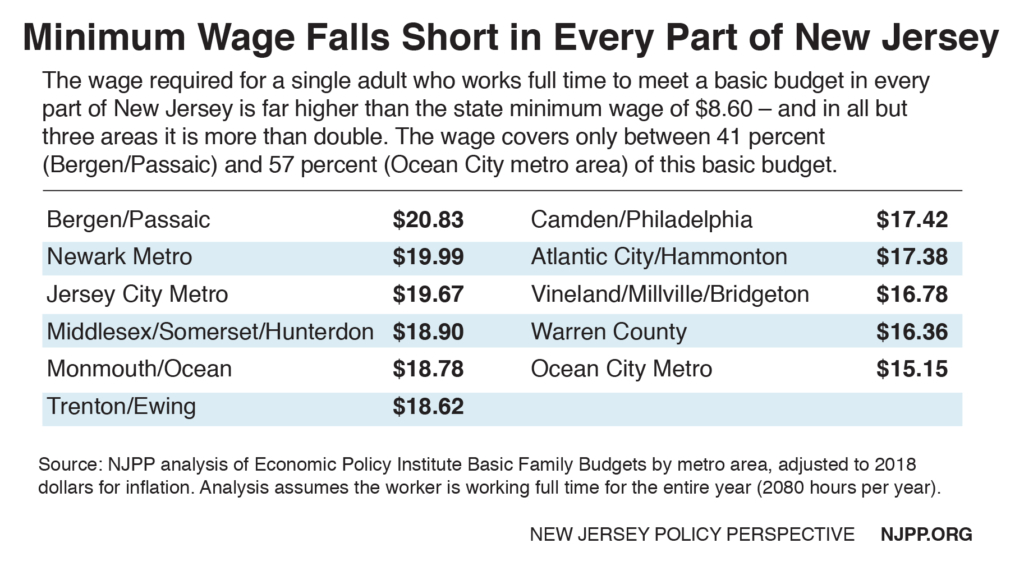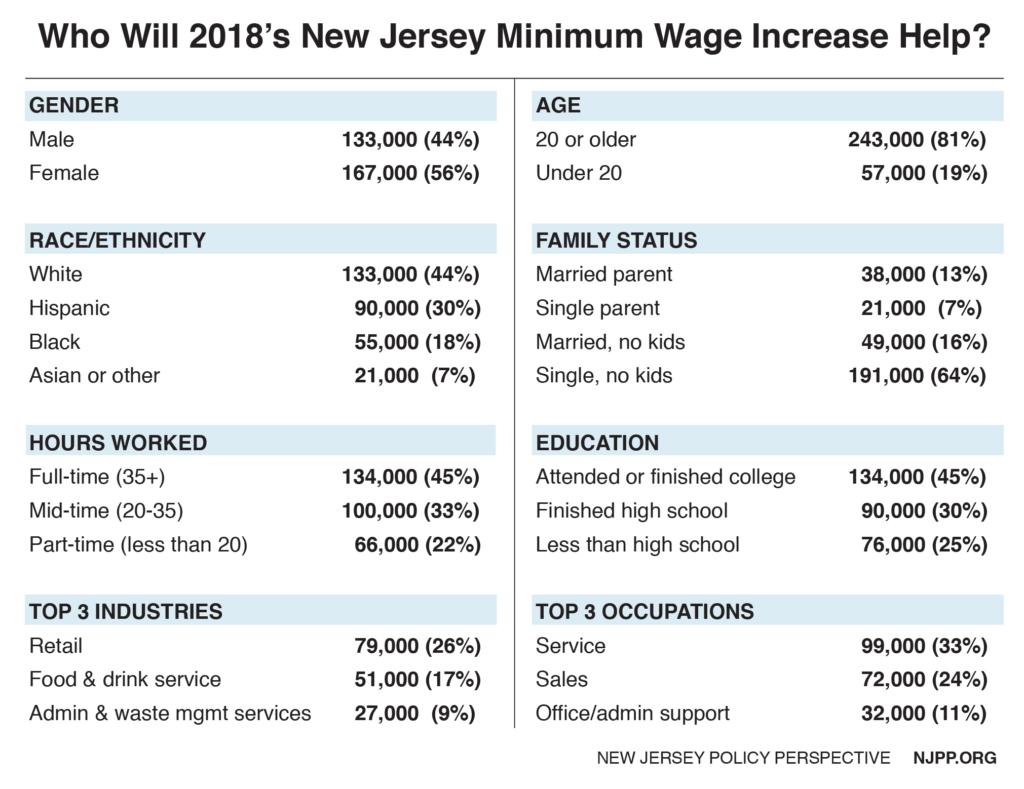16-cent inflation adjustment is good news but lawmakers must do more to boost workers and the state’s economy
To read a PDF version of this report, click here.
 On January 1, 2018, New Jersey’s minimum wage will rise by 1.9 percent to $8.60 per hour,[1] providing approximately 300,000 workers throughout the state with a small but welcomed pay increase.
On January 1, 2018, New Jersey’s minimum wage will rise by 1.9 percent to $8.60 per hour,[1] providing approximately 300,000 workers throughout the state with a small but welcomed pay increase.
While it was prudent of policymakers to index the minimum wage to the rate of inflation – helping ensure that workers don’t fall further behind than they already are – the fact remains that a minimum wage of $8.60 per hour isn’t nearly enough for a single low-wage worker to make ends meet in the Garden State.
A full-time worker at the minimum wage in 2018 will take home less than $18,000 for the year, assuming they don’t take any time off. According to analysis by the Economic Policy Institute, a single worker in the Garden State needs to make $37,974 in 2018 just to earn a wage that can provide stability.[2]
Fortunately, Governor-Elect Murphy and legislative leaders have made it clear that they intend to increase the minimum wage to $15 per hour, a move that would help a diverse group of workers – nearly 25 percent of the workforce – and improve their chances of being able to provide for themselves and their families in our high-cost state.[3]
In the meantime, the January 1 increase to $8.60 per hour will boost the wages of 7.5 percent of New Jersey’s workforce. Of the 300,000 workers affected by the wage increase, 91,000 are directly affected – meaning they currently make between $8.44 and $8.60 per hour – and the remaining 209,000 are indirectly affected – meaning they currently make between $8.60 and $8.76 per hour, and will see an increase in their pay as employers adjust their pay scales upward to reflect the new minimum wage.[4]
On average, these 300,000 workers will see their annual earnings rise by $469 in 2018. The total increase for all affected workers will be $140.5 million in 2018. While it is important that the minimum wage is increasing in 2018, the change represents just an average hike of $9.02 a week – not nearly enough to allow a worker to get by, let alone climb into the middle class.
In fact, the basic cost of living in 2018 for a single adult working full time requires an hourly wage between $15.15 in the Ocean City metro area and $20.83 in the Bergen-Passaic metro area – far above the 2018 minimum wage of $8.60 an hour.[5]
This basic family budget, designed by the Economic Policy Institute, includes money for the major expenses of housing, food, transportation, health care, child care and taxes, as well as modest amounts for other necessary items like clothing, personal care items, school supplies, entertainment and household supplies. It does not include other typical expenditures of a middle-class family like weekend trips or savings of any kind.[6]
January 1 Increase Will Help a Diverse Group of Low-Paid Workers
Due to ongoing shifts in the nature of low-wage work in America, the low-paid Garden State workers who will see a boost from the January 1 increase are older, more educated and working more hours than they have been in decades – despite the insistence of minimum wage opponents that low-paid workers are primarily teenagers looking for extra cash.[7]
Four of every five workers who will get a raise (81 percent) are at least 20 years old, while most are working either full-time (45 percent) or between 20 and 35 hours a week (33 percent). Almost half – 44.6 percent – have attended or finished college, and an additional 30 percent have finished high school.
The majority, 56 percent, are women and one in five – 20 percent – are parents. A total of 111,000 New Jersey kids have at least one parent who will benefit from the January 1 increase. When looking at race and ethnicity, 44 percent of affected workers are white, 30 percent are Hispanic, and 18 percent are black.
Endnotes
[1] New Jersey Department of Labor and Workforce Development, Notice of Administrative Changes N.J.A.C. 12:56-3.1, September 2017.
[2] NJPP analysis of Economic Policy Institute family budgets by metro area, adjusted to 2018 to account for inflation using projections for the Consumer Price Index from the Congressional Budget Office. Calculations assume each adult is working full-time for the entire year (2080 hours per adult).
[3] New Jersey Policy Perspective and the Economic Policy Institute, Raising the Minimum Wage to $15 by 2024 Would Boost the Pay of 1.2 Million New Jerseyans, May 2017.
[4] All economic and demographic information in this report is from the Economic Policy Institute’s analysis of the Current Population Survey (CPS), Outgoing Rotation Group public use microdata from the fourth quarter of 2013 to the third quarter of 2014. The number of workers is estimated from the CPS respondents for whom either a valid hourly wage is reported or one can be imputed from weekly earnings and average weekly hours. Consequently, this estimate tends to understate the size of the full workforce. All figures are rounded for clarity and readability.
[5] Ibid 2
[6] For more on how the family budgets are calculated, see: http://www.epi.org/resources/budget/
[7] For example, see: Center for Economic and Policy Research, Low-Wage Workers Are Older and Better-Educated Than Ever, April 2012.



